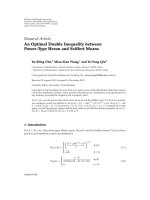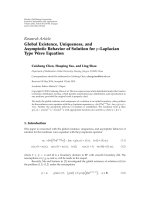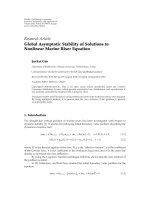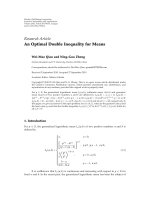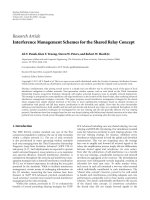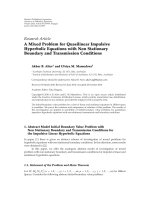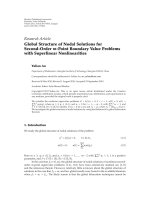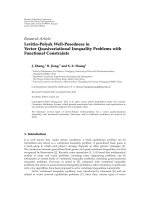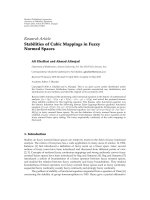Báo cáo sinh học: " Research Article Global Optimal Regularity for the Parabolic Polyharmonic Equations" pptx
Bạn đang xem bản rút gọn của tài liệu. Xem và tải ngay bản đầy đủ của tài liệu tại đây (511.38 KB, 12 trang )
Hindawi Publishing Corporation
Boundary Value Problems
Volume 2010, Article ID 879821, 12 pages
doi:10.1155/2010/879821
Research Article
Global Optimal Regularity for
the Parabolic Polyharmonic Equations
Fengping Yao
Department of Mathematics, Shanghai University, Shanghai 200436, China
Correspondence should be addressed to Fengping Yao,
Received 21 February 2010; Accepted 3 June 2010
Academic Editor: Vicentiu D. Radulescu
Copyright q 2010 Fengping Yao. This is an open access article distributed under the Creative
Commons Attribution License, which permits unrestricted use, distribution, and reproduction in
any medium, provided the original work is properly cited.
We show the global regularity estimates for the following parabolic polyharmonic equation
u
t
−Δ
m
u f in R
n
× 0, ∞,m ∈ Z
under proper conditions. Moreover, it will be verified
that these conditions are necessary for the simplest heat equation u
t
− Δu f in R
n
× 0, ∞.
1. Introduction
Regularity theory in PDE plays an important role in the development of second-order
elliptic and parabolic equations. Classical regularity estimates for elliptic and parabolic
equations consist of Schauder estimates, L
p
estimates, De Giorgi-Nash estimates, Krylov-
Safonov estimates, and so on. L
p
and Schauder estimates, which play important roles in
the theory of partial differential equations, are two fundamental estimates for elliptic and
parabolic equations and the basis for the existence, uniqueness, and regularity of solutions.
The objective of this paper is to investigate the generalization of L
p
estimates, that is,
regularity estimates in Orlicz spaces, for the following parabolic polyharmonic problems:
u
t
x, t
−Δ
m
u
x, t
f
x, t
in R
n
×
0, ∞
, 1.1
u
x, 0
0inR
n
, 1.2
where x x
1
, ,x
n
, Δ
n
i1
∂
2
/∂x
2
i
and m is a positive integer. Since the 1960s, the
need to use wider spaces of functions than Sobolev spaces arose out of various practical
problems. Orlicz spaces have been studied as t he generalization of Sobolev spaces since they
were introduced by Orlicz 1see 2–6. The theory of Orlicz spaces plays a crucial role in
many fields of mathematics see 7.
2 Boundary Value Problems
We denote the distance in R
n1
as
δ
z
1
,z
2
max
|
x
1
− x
2
|
,
|
t
1
− t
2
|
1/2m
for z
1
x
1
,t
1
,z
2
x
2
,t
2
1.3
and the cylinders in R
n1
as
Q
R
B
R
×
−R
2m
,R
2m
,Q
R
z
Q
R
z, z
x, t
∈ R
n1
, 1.4
where B
R
{x ∈ R
n
: |x| <R} is an open ball in R
n
. Moreover, we denote
D
ν
x
u
∂
|ν|
u
∂
ν
1
x
1
···∂
ν
n
x
n
, 1.5
where ν ν
1
,ν
2
, ,ν
n
is a multiple index, ν
i
≥ 0 i 1, 2, ,n, and |ν|
n
i1
|ν
i
|. For
convenience, we often omit the subscript x in D
ν
x
u and write D
k
u {D
ν
u : |ν| k}.
Indeed if m 1, then 1.1 is simplified to be the simplest heat equation. L
p
estimates
and Schauder estimates for linear second-order equations are well known see 8, 9. When
m
/
1, the corresponding regularity results for the higher-order parabolic equations are less.
Solonnikov 10 studied L
p
and Schauder estimates for the general linear higher-order
parabolic equations with the help of fundamental solutions and Green functions. Moreover,
in 11 we proved global Schauder estimates for the initial-value parabolic polyharmonic
problem using the uniform approach as the second-order case. Recently we 6 generalized
the local L
p
estimates to the Orlicz space
Q
1/6
φ
D
2m
u
2
dz
Q
1/6
φ
|
u
t
|
2
dz ≤ C
Q
1/2
φ
f
2
dz
Q
1/2
φ
|
u
|
2
dz
1.6
for
u
t
z
−Δ
m
u
z
f
z
in Ω ×
0,T
, 1.7
where φ ∈ Δ
2
∩∇
2
see Definition 1.2 and Ω is an open bounded domain in R
n
. When
φx|x|
p/2
with p>2, 1.6 is reduced to the local L
p
estimates. In fact, we can replace 2 of
φ|·|
2
in 1.6 by the power of p
1
for any p
1
> 1.
Our purpose in this paper is to extend local regularity estimate 1.3 in 6 to global
regularity estimates, assuming that φ ∈ Δ
2
∩∇
2
. Moreover, we will also show that the Δ
2
∩∇
2
condition is necessary for the simplest heat equation u
t
− Δu f in R
n
× 0, ∞. In particular,
we are interested in the estimate like
R
n
×0,∞
φ
D
2m
u
dz
R
n
×0,∞
φ
|
u
t
|
dz ≤ C
R
n
×0,∞
φ
f
dz,
1.8
where C is a constant independent from u and f. Indeed, if φx|x|
p
with p>1, 1.8
is reduced to classical L
p
estimates. We remark that although we use similar functional
Boundary Value Problems 3
framework and iteration-covering procedure as in 6, 12, more complicated analysis should
be carefully carried out with a proper dilation of the unbounded domain.
Here for the reader’s convenience, we will give some definitions on the general Orlicz
spaces.
Definition 1.1. A convex function φ : R → R
is said to be a Young function if
φ
−s
φ
s
,φ
0
0, lim
s →∞
φ
s
∞.
1.9
Definition 1.2. A Young function φ is said to satisfy the global Δ
2
condition, denoted by φ ∈
Δ
2
, if there exists a positive constant K such that for every s>0,
φ
2s
≤ Kφ
s
. 1.10
Moreover, a Young function φ is said to satisfy the global ∇
2
condition, denoted by φ ∈∇
2
,if
there exists a number a>1 such that for every s>0,
φ
s
≤
φ
as
2a
.
1.11
Example 1.3. i φ
1
s1 |s| log1 |s| −|s|∈Δ
2
,butφ
1
s
/
∈∇
2
.
ii φ
2
se
|s|
−|s|−1 ∈∇
2
,butφ
2
s
/
∈Δ
2
.
iii φ
3
s|s|
α
1 |log |s|| ∈ Δ
2
∩∇
2
, α>1.
Remark 1.4. If a function φ satisfies 1.10 and 1.11, then
φ
θ
1
s
≤ Kθ
α
1
1
φ
s
,φ
θ
2
s
≤ 2aθ
α
2
2
φ
s
, 1.12
for every s>0and0<θ
2
≤ 1 ≤ θ
1
< ∞, where α
1
log
2
K and α
2
log
a
2 1.
Remark 1.5. Under condition 1.12, it is easy to check that φ satisfies
φ
0
0, lim
s →∞
φ
s
∞, lim
s →0
φ
s
s
lim
s →∞
s
φ
s
0.
1.13
Definition 1.6. Assume that φ is a Young function. Then the Orlicz class K
φ
R
n
is the set of
all measurable functions g : R
n
→ R satisfying
R
n
φ
g
dx < ∞.
1.14
The Orlicz space L
φ
R
n
is the linear hull of K
φ
R
n
.
4 Boundary Value Problems
Lemma 1.7 see 2. Assume that φ ∈ Δ
2
∩∇
2
and g ∈ L
φ
Ω.Then
1 K
φ
Ω L
φ
Ω,
2 C
∞
0
Ω is dense in L
φ
Ω,
3
Ω
φ
g
dx
∞
0
x ∈ Ω :
g
>μ
d
φ
μ
.
1.15
Now let us state the main results of this work.
Theorem 1.8. Assume that φ is a Young function and u satisfies
u
t
x, t
− Δu
x, t
f
x, t
in R
n
×
0, ∞
,
u
x, 0
0 in R
n
.
1.16
Then if the following inequality holds
R
n
×0,∞
φ
D
2
u
dz
R
n
×0,∞
φ
|
u
t
|
dz ≤ C
R
n
×0,∞
φ
f
dz,
1.17
One has
φ ∈ Δ
2
∩∇
2
. 1.18
Theorem 1.9. Assume that φ ∈ Δ
2
∩∇
2
.Ifu is the solution of 1.1-1.2 with f ∈ L
φ
R
n
×0, ∞,
then 1.8 holds.
Remark 1.10. We would like to point out that the Δ
2
condition is necessary. In fact, if the local
L
φ
estimate 1.6m 1 is true, then by choosing
u
√
2s
1/2
x
1
x
2
,f 0 ∀s>0
1.19
we have
Q
1/6
φ
2s
dz
Q
1/6
φ
⎛
⎝
∂
2
u
∂x
1
∂x
2
2
⎞
⎠
dz
≤ C
Q
1/2
φ
f
2
dz
Q
1/2
φ
|
u
|
2
dz
≤ C
Q
1/2
φ
s
dz,
1.20
Boundary Value Problems 5
which implies that
φ
2s
≤ Cφ
s
, for any s>0. 1.21
2. Proof of Theorem 1.8
In this section we show that φ satisfies the global ∇
2
condition if u satisfies 1.16 and estimate
1.17 is true.
Proof. Now we consider the special case in 1.16 when
f
z
ρη
z
2.1
for any constant ρ>0, where z x, t and η ∈ C
∞
0
R
n1
is a cutoff function satisfying
0 ≤ η ≤ 1,η≡ 1inB
1
×
−1, 1
,η≡ 0in
R
n1
{
B
2
×
−2, 2
}
.
2.2
Therefore the problem 1.16 has the solution
u
x, t
t
0
1
4π
t − s
n/2
R
n
e
−|x−y|
2
/4t−s
f
y, s
dy ds.
2.3
It follows from 1.17, 2.1,and2.2 that
R
n
×0,∞
φ
|
u
t
|
dz ≤ C
R
n
×0,∞
φ
f
dz ≤ C
1
φ
ρ
.
2.4
We know from 2.3 that
u
t
x, t
1
4π
n/2
t
0
1
t − s
n2/2
B
2
x − y
2
4
t − s
−
n
2
e
−|x−y|
2
/4t−s
f
y, s
dy ds.
2.5
Define
D :
z
x, t
∈ R
n
×
0, ∞
:
|
x
|
> 4,
|
x
|
≥ 4
√
nt
. 2.6
Then when z ∈ D, t > s and y ∈ B
2
, we have
x − y
2
4
t − s
≥
|
x
|
2
16t
≥ n,
2.7
6 Boundary Value Problems
since
x − y
≥
|
x
|
−
y
≥
|
x
|
−
|
x
|
2
|
x
|
2
.
2.8
Therefore, since |x − y|≤|x| |y|≤2|x| for z ∈ D and y ∈ B
2
, we conclude t hat
|
u
t
x, t
|
≥
nρ
2 ·
4π
n/2
t
0
1
t − s
n2/2
B
1
e
−|x−y|
2
/4t−s
dy ds
≥
nρ
2 ·
4π
n/2
t
0
1
t − s
y∈B
1
e
−|ξ|
2
/4
dξ ds ξ
x − y
t − s
≥
nρ
2 ·
4π
n/2
t
0
t − s
n−2/2
2
|
x
|
n
y∈B
1
|
ξ
|
n
e
−|ξ|
2
/4
dξ ds
≥ Cρ
|
x
|
−n
t
0
t − s
n−2/2
ds ≥ C
2
ρ
|
x
|
−n
t
n/2
.
2.9
Recalling estimate 2.4 we find that
D
φ
C
2
ρ
|
x
|
−n
t
n/2
dx dt ≤ C
1
φ
ρ
,
2.10
which implies that
1
1/n
∞
4
√
n
φ
C
2
ρr
−n
r
n−1
dr
dt ≤ C
1
φ
ρ
. 2.11
By changing variable we conclude that, for any ρ>0,
αρ
0
φ
σ
σ
2
dσ ≤
C
3
φ
ρ
ρ
,
2.12
where α C
2
4
−n
n
−n/2
.Letρ
2
≥ ρ
1
and 0 <ε≤ α/2. Then we conclude from 2.12 that
φ
ρ
2
ρ
2
≥
1
C
3
αρ
2
0
φ
σ
σ
2
dσ ≥
1
C
3
αρ
1
ερ
1
φ
σ
σ
2
dσ
≥
φ
ερ
1
C
3
1
ερ
1
−
1
αρ
1
≥
φ
ερ
1
2C
3
ερ
1
.
2.13
Now we use 2.12 and 2.13 to obtain that
φ
ρ
ρ
≥
1
C
3
αρ
ερ
φ
σ
σ
1
σ
dσ ≥
φ
ε
2
ρ
2C
2
3
ε
2
ρ
ln
α
ε
,
2.14
Boundary Value Problems 7
where we choose that ρ
1
ερ, ρ
2
σ in 2.13.Seta 1/ε
2
. Then we have
φ
ρ
≥
ln
α
√
a
2C
2
3
aφ
ρ
a
≥ 2aφ
ρ
a
,
2.15
when a is chosen large enough. This implies that φ satisfies the ∇
2
condition. Thus this
completes our proof.
3. Proof of the Main Result
In this section, we will finish the proof of the main result, Theorem 1.9.Justas6, we will
use the following two lemmas. The first lemma is the following integral inequality.
Lemma 3.1 see 6. Let φ ∈ Δ
2
∩∇
2
, g ∈ L
φ
R
n1
, and p ∈ 1,α
2
,whereα
2
is defined in 1.12.
Then for any b
1
,b
2
> 0 one has
∞
0
1
μ
p
{z∈R
n1
:|g|>b
1
μ}
g
p
dz
d
φ
b
2
μ
≤ C
b
1
,b
2
,φ
R
n1
φ
g
dz. 3.1
Moreover, we recall the following result.
Lemma 3.2 see 10, Theorem 5.5. Assume that g ∈ L
p
R
n
× 0, ∞ for p>1.Thereexistsa
unique solution v ∈ W
2m,1
p
R
n
× 0, ∞ of 1.1-1.2 with the estimate
D
2m
v
L
p
R
n
×0,∞
v
t
L
p
R
n
×0,∞
≤ C
g
L
p
R
n
×0,∞
.
3.2
Moreover, we give one important lemma, which is motivated by the iteration-covering
procedure in 12. To start with, let u be a solution of 1.1-1.2.Let
p
1 α
2
2
> 1.
3.3
In fact, in the subsequent proof we can choose any constant p with 1 <p<α
2
. Now we write
λ
p
0
R
n
×0,∞
D
2m
u
p
dz
1
R
n
×0,∞
f
p
dz,
3.4
while ∈ 0, 1 is a small enough constant which will be determined later. Set
u
λ
u
λ
0
λ
,f
λ
f
λ
0
λ
3.5
8 Boundary Value Problems
for any λ>0. Then u
λ
is still the solution of 1.1-1.2 with f
λ
replacing f. Moreover, we
write
J
λ
Q
−
Q
D
2m
u
λ
p
dz
1
−
Q
f
λ
p
dz
3.6
for any domain Q in R
n1
and the level set
E
λ
1
z ∈ R
n
×
0, ∞
:
D
2m
u
λ
> 1
. 3.7
Next, we will decompose the level set E
λ
1.
Lemma 3.3. For any λ>0, there exists a family of disjoint cylinders {Q
ρ
i
z
i
}
i∈N
with z
i
x
i
,t
i
∈
E
λ
1 and ρ
i
ρz
i
,λ > 0 such that
J
λ
Q
ρ
i
z
i
1,J
λ
Q
ρ
z
i
< 1 for any ρ>ρ
i
, 3.8
E
λ
1
⊂
i∈N
Q
5ρ
i
z
i
∪ negligible set,
3.9
where Q
5ρ
i
z
i
: B
5ρ
i
x
i
× t
i
− 5ρ
i
2m
,t
i
5ρ
i
2m
. Moreover, one has
Q
ρ
i
z
i
≤ 2
{z∈Q
ρ
i
z
i
:|D
2m
u
λ
|
p
>1/4}
D
2m
u
λ
p
dz
1
{z∈Q
ρ
i
z
i
:|f
λ
|
p
>/4}
f
λ
p
dz
.
3.10
Proof. 1 Fix any λ>0. We first claim that
sup
w∈R
n
×0,∞
sup
ρ≥ρ
0
J
λ
Q
ρ
w
≤ 1,
3.11
where ρ
0
ρ
0
λ > 0satisfiesλ
p
|Q
ρ
0
| 1. To prove this, fix any w ∈ R
n
× 0, ∞ and ρ ≥ ρ
0
.
Then it follows from 3.4 that
J
λ
Q
ρ
w
≤
1
λ
p
0
λ
p
Q
ρ
w
R
n
×0,∞
D
2m
u
p
dz
1
R
n
×0,∞
f
p
dz
≤
1
λ
p
Q
ρ
0
1.
3.12
2 For a.e. w ∈ E
λ
1, from Lebesgue’s differentiation theorem we have
lim
ρ →0
J
λ
Q
ρ
w
> 1,
3.13
Boundary Value Problems 9
which implies that there exists some ρ>0 satisfying
J
λ
Q
ρ
w
> 1. 3.14
Therefore from 3.11 we can select a radius ρ
w
∈ 0,ρ
0
such that
J
λ
Q
ρ
w
w
1,J
λ
Q
ρ
w
< 1 for any ρ>ρ
w
. 3.15
Therefore, applying Vitali’s covering lemma, we can find a family of disjoint cylinders
{Q
ρ
i
z
i
} such that 3.8 and 3.9 hold.
3 Equation 3.8 implies that
−
Q
ρ
i
z
i
D
2m
u
λ
p
dz
1
−
Q
ρ
i
z
i
f
λ
p
dz 1.
3.16
Therefore, by splitting the two integrals above as follows we have
Q
ρ
i
z
i
≤
{z∈Q
ρ
i
z
i
:|D
2m
u
λ
|
p
>1/4}
D
2m
u
λ
p
dz
cQ
ρ
i
z
i
4
1
{z∈Q
ρ
i
z
i
:|f
λ
|
p
>/4}
f
λ
p
dz
Q
ρ
i
z
i
4
.
3.17
Thus we can obtain the desired result 3.10.
Now we are ready to prove the main result, Theorem 1.9.
Proof. In the following by the elementary approximation argument as 3, 12 it is sufficient
to consider the proof of 1.8 under the additional assumption that D
2m
u ∈ L
φ
R
n
× 0, ∞.
In view of Lemma 3.3,givenanyλ>0, we can construct a family of cylinders {Q
ρ
i
z
i
}
i∈N
,
where z
i
x
i
,t
i
∈ E
λ
1.Fixi ≥ 1. It follows from 3.6 and 3.8 in Lemma 3.3 that
−
Q
10ρ
i
z
i
D
2m
u
λ
p
dz ≤ 1,
−
Q
10ρ
i
z
i
f
λ
p
dz ≤ .
3.18
We first extend f
λ
from Q
10ρ
i
z
i
to R
n1
by the zero extension and denote by f
λ
.From
Lemma 3.2, there exists a unique solution v ∈ W
2m,1
p
R
n
× 0, ∞ of
v
t
−Δ
2m
v f
λ
in R
n
×
0, ∞
,
v 0inR
n
×
{
t 0
}
3.19
with the estimate
D
2m
v
L
p
R
n
×0,∞
≤ C
f
λ
L
p
R
n
×0,∞
.
3.20
10 Boundary Value Problems
Therefore we see that
D
2m
v
L
p
Q
10ρ
i
z
i
≤
D
2m
v
L
p
R
n
×0,∞
≤ C
f
λ
L
p
R
n
×0,∞
C
f
λ
L
p
Q
10ρ
i
z
i
.
3.21
Set w u
λ
− v. Then we know that
w
t
−Δ
2m
w 0inQ
10ρ
i
z
i
.
3.22
Moreover, by 3.18 and 3.21 we have
−
Q
10ρ
i
z
i
D
2m
w
p
dz ≤ 2
p
−
Q
10ρ
i
z
i
D
2m
v
p
dz
−
Q
10ρ
i
z
i
D
2m
v
p
dz
≤ 2
p
C
−
Q
10ρ
i
z
i
f
λ
p
dz ≤ C.
3.23
Thus from the elementary interior W
2m,1
∞
regularity, we know that there exists a constant
N
1
> 1 such that
sup
Q
5ρ
i
z
i
D
2m
w
≤ N
1
.
3.24
Set μ λλ
0
. Therefore, we deduce from 3.5 and 3.24 that
z ∈ Q
5ρ
i
z
i
:
D
2m
u
> 2N
1
μ
z ∈ Q
5ρ
i
z
i
:
D
2m
u
λ
> 2N
1
≤
z ∈ Q
5ρ
i
z
i
:
D
2m
w
>N
1
z ∈ Q
5ρ
i
z
i
:
D
2m
v
>N
1
z ∈ Q
5ρ
i
z
i
:
D
2m
v
>N
1
≤
1
N
p
1
Q
5ρ
i
z
i
D
2m
v
p
dz.
3.25
Then according to 3.18 and 3.21, we discover
z ∈ Q
5ρ
i
z
i
:
D
2m
u
> 2N
1
μ
≤ C
Q
10ρ
i
z
i
f
λ
p
dz ≤ C
Q
10ρ
i
z
i
C
Q
ρ
i
z
i
.
3.26
Boundary Value Problems 11
Therefore, from 3.10 in Lemma 3.3 we find that
z ∈ Q
5ρ
i
z
i
:
D
2m
u
> 2N
1
μ
≤
C
μ
p
{z∈Q
ρ
i
z
i
:|D
2m
u|
p
>μ
p
/4}
D
2m
u
p
dz
{z∈Q
ρ
i
z
i
:|f|>μ
p
/4}
f
p
dz
,
3.27
where C Cn, m. Recalling the fact that the cylinders {Q
ρ
i
z
i
}
i∈N
are disjoint,
i∈N
Q
5ρ
i
z
i
∪ negligible set ⊃ E
λ
1
z ∈ R
n
×
0, ∞
:
D
2m
u
λ
z
> 1
,
3.28
and then summing up on i ∈ N in the inequality above, we have
z ∈ R
n
×
0, ∞
:
D
2m
u
> 2N
1
μ
≤
i∈N
z ∈ Q
5ρ
i
z
i
:
D
2m
u
> 2N
1
μ
≤
C
μ
p
{z∈R
n
×0,∞:|D
2m
u|
p
>μ
p
/4}
D
2m
u
p
dz
{z∈R
n
×0,∞:|f|>μ
p
/4}
f
p
dz
.
3.29
Therefore, from Lemma 1.73 and the inequality above we have
R
n
×0,∞
φ
D
2m
u
dz
∞
0
z ∈ R
n
×
0, ∞
:
D
2m
u
> 2N
1
μ
d
φ
2N
1
μ
≤ C
∞
0
1
μ
p
{z∈R
n
×0,∞:|D
2m
u|
p
>μ
p
/4}
D
2m
u
p
dz
d
φ
2N
1
μ
C
∞
0
1
μ
p
{z∈R
n
×0,∞:|f|>μ
p
/4}
f
p
dz
d
φ
2N
1
μ
.
3.30
Consequently, from Lemma 3.1 we conclude that
R
n
×0,∞
φ
D
2m
u
dz ≤ C
1
R
n
×0,∞
φ
D
2m
u
dz C
2
R
n
×0,∞
φ
f
dz,
3.31
where C
1
C
1
n, m, φ and C
2
C
2
n, m, , φ. Finally selecting a suitable ∈ 0, 1 such that
C
1
≤ 1/2, we finish the proof.
12 Boundary Value Problems
Acknowledgments
The author wishes to thank the anonymous referee for offering valuable suggestions to
improve the expressions. This work is supported in part by Tianyuan Foundation 10926084
and Research Fund for the Doctoral Program of Higher Education of China 20093108120003.
Moreover, the author wishes to thank the department of mathematics at Shanghai university
which was supported by the Shanghai Leading Academic Discipline Project J50101 and Key
Disciplines of Shanghai Municipality S30104.
References
1 W. Orlicz, “
¨
Uber eine gewisse Klasse von R
¨
aumen vom Typus B,” Bulletin International de l’Acad
´
emie
Polonaise S
´
erie A, vol. 8, pp. 207–220, 1932.
2 R. A. Adams and J. J. F. Fournier, Sobolev Spaces, vol. 140, Academic Press, Amsterdam, The
Netherlands, 2nd edition, 2003.
3 S. Byun, F. Yao, and S. Zhou, “Gradient estimates in Orlicz space for nonlinear elliptic equations,”
Journal of Functional Analysis, vol. 255, no. 8, pp. 1851–1873, 2008.
4 H. Jia, D. Li, and L. Wang, “Regularity of Orlicz spaces for the Poisson equation,” Manuscripta
Mathematica, vol. 122, no. 3, pp. 265–275, 2007.
5 V. Kokilashvili and M. Krbec, Weighted inequalities in Lorentz and Orlicz spaces, World Scientific, River
Edge, NJ, USA, 1991.
6 F. Yao, “Regularity theory in Orlicz spaces for the parabolic polyharmonic equations,” Archiv der
Mathematik, vol. 90, no. 5, pp. 429–439, 2008.
7 M. M. Rao and Z. D. Ren, Applications of Orlicz Spaces, vol. 250 of Monographs and Textbooks in Pure and
Applied Mathematics, Marcel Dekker, New York, NY, USA, 2002.
8 D. Gilbarg and N. Trudinger, Elliptic Partial Differential Equations of Second Order, Springer, Berlin,
Germany, 3rd edition, 1998.
9 G. M. Lieberman, Second Order Parabolic Differential Equations, World Scientific, River Edge, NJ, USA,
1996.
10 V. A. Solonnikov, “On boundary value problems for linear parabolic systems of differential equations
of general form,” Trudy Matematicheskogo Instituta Imeni V. A. Steklova, vol. 83, pp. 3–163, 1965.
11 F P. Yao and S L. Zhou, “Schauder estimates for parabolic equation of bi-harmonic type,” Applied
Mathematics and Mechanics, vol. 28, no. 11, pp. 1503–1516, 2007.
12 E. Acerbi and G. Mingione, “Gradient estimates for a class of parabolic systems,” Duke Mathematical
Journal, vol. 136, no. 2, pp. 285–320, 2007.

